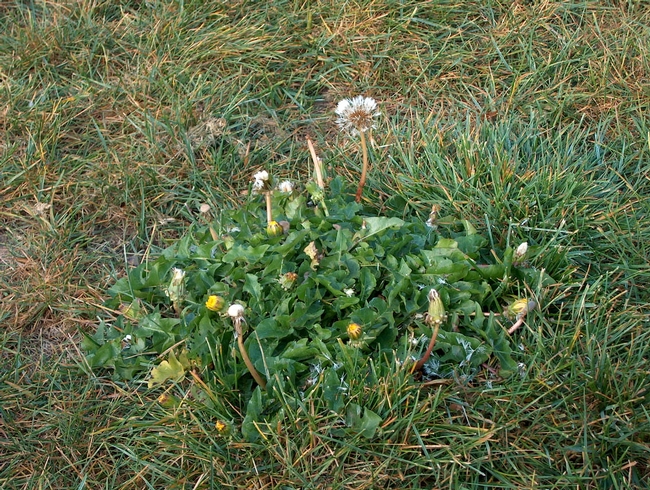
Sure enough,a little research enlightened me about the good side of this troublesome weed. The dandelion that grows in the Napa Valley (Taraxacumofficinale) is, in my opinion, a major problem in the garden. Thriving in just about any garden venue, dandelions have a taproot that is hard to remove permanently.
The dandelion has been used as a pot herb and medicinal plant since Roman times. The seeds were so valued that people carried them on the Mayflower to the New World. High in vitamins and minerals, the young leaves are eaten in salads; the mature blossoms scent dandelion wine; and the roots are brewed for a coffee substitute. The dried leaves can be steeped for a mild tea, and the dried roots are a mild diuretic. I remember, as a child, seeing my dad come in from the yard with fresh dandelion leaves for the salad. My mom was not amused.
I am sure that my fellow gardeners agree that these plants are persistent. Although the taproot does break up the soil and provide nutrients for other plants, I'm not ready to give it any encouragement yet.
I have worked and worked to remove dandelions from my lawn, positive that I had the entire root structure only to have this annoying plant re-emerge in a few weeks. Dandelions prefer moist areas in full sun but can survive in some shade and dry soil if they get established.
The plant grows pretty much year-round in California except in the coldest areas, where it lies in wait for warmer weather. The taproot, while usually only 6 to 8 inches long, can reach 10 to 15 feet. No wonder I have a problem getting it all.
The leaves grow in a rosette.They have no true stems. Leaves are usually two to four inches wide and about up to fourteen inches long. Some have smooth edges; others have a jagged, tooth-like appearance that explains the plant's name. Dandelion comes from “dent de lion,” which is French for lion's tooth.
As a child, I picked the flowers to make necklaces, and then blew on the seed balls to watch the puffs float on the wind. No wonder this plant is prevalent. The seed heads have up to 300 seeds, which can travel by wind, sometimes helped by the breath of children, for miles.
There are more than 60 dandelion species. Taraxacumofficinale has small leaves, so harvesting them is labor intensive. If you are thinking of selling your crop, that idea is probably a “no go.” The summer dandelion is more upright, with larger leaves that are easier to harvest. For the most part, the variety sold in grocery stores is a hybrid of the chicories‘San Pasquale' and ‘Catalogna'. Commercial dandelion farmers are required to control their seed in some manner. Can you imagine living downwind from a dandelion farm?
The most interesting species of dandelion by far is the Taraxacumkoki-saghyz, also known as TKS or Russian dandelion. This variety has greyish upright foliage and more natural latex than the others types. During World War II, rubber supplies were sorely depleted. The Swedish Seed Association conducted a dandelion breeding program to increase the latex content in the root. The new TKS produced four to five times more usable latex than the common dandelion.
The Swedish study had been back-burnered until recently, when automotive-industry researchers began investigating TKS as a source of rubber for tires. Other scientists are looking closely at the hypoallergenic properties of the latex from this species, and exploring whether it could be used as a source of ethanol.So as you wrestle with dandelions in your landscape, keep its positive attributes in mind. One gardener's weed is another person's dinner.
Workshop: Napa County Master Gardeners will conduct a workshop on “Habitat Gardens at Home or School” on Saturday, May 16, from 9:30 a.m. to 11:30 a.m., at Skyline Park, Martha Walker Garden, 2201 Imola Avenue, Napa. Participants will tour the Martha Walker Garden to discover the plants and garden elements that attract bees, birds and pollinators. Master Gardeners will explain the value of habitat corridors whether the garden is in a rural, urban, or school setting. Online registration (credit card only) Mail-in registration (cash or check only)
Master Gardeners are volunteers who help the University of California reach the gardening public with home gardening information. Napa County Master Gardeners ( http://ucanr.org/ucmgnapa/) are available to answer gardening questions in person or by phone, Monday, Wednesday and Friday, 9 a.m. to Noon, at the U. C. Cooperative Extension office, 1710 Soscol Avenue, Suite 4, Napa, 707-253-4143, or from outside City of Napa toll-free at 877-279-3065. Or e-mail your garden questions by following the guidelines on our web site. Click on Napa, then on Have Garden Questions? Find us on Facebook under UC Master Gardeners of Napa County.
Attached Images:
